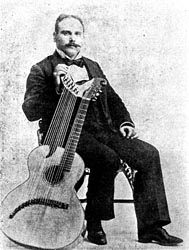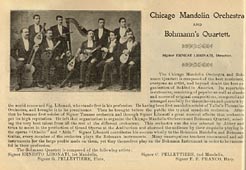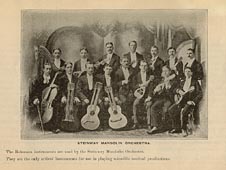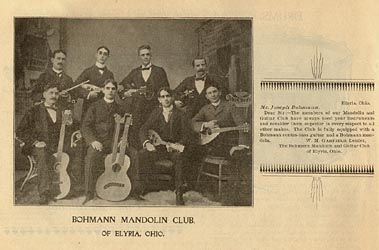![]()
Bohmann c.1899 Catalog (modified slightly from the c.1896 catalog)
(Excerpts of all Harp Guitar Pages)
See also "A Harp Guitar Surprise Among Bohmann’s Printing Blocks"
| Text from page 70 (image at right)
JOSEPH BOHMANN’S NEW CONTRA BASS HARP GUITAR The New Contra Bass Harp Guitar is made to order only, in rosewood and best curly and birdseye maple, with double neck and Bohmann’s new patent machine bridge, and is positively the largest guitar ever made. Its measurements are: Length of body, 23 inches; across body back of bridge, 19 inches; and depth of body, 6 inches. A harp key is used for tuning the contra bass strings. The harp guitar is finished as No. 3. Price for 12-string harp guitar is….….....$163.00 “ “ 18 “ “ “ ……....$175.00 This guitar is made in 12 and 18 strings. Its tone has been tested with two harps at the same time, by the eminent Guitar Virtuoso, Sig. Emilio Calamara, of Chicago, for whom the first contra bass harp guitar was made in America by the world’s greatest musical instrument manufacturer, Joseph Bohmann. He claims that the strength and tone carrying power of the guitar was superior to two harps combined. The harp guitar will be made in regular guitar styles from No. 1 to 14, inclusive. |
Immediately after the Contra Bass Harp Guitar, a "Grand Concert Contra Bass Guitar" is listed. It appears to be a large 6-string guitar, perhaps tuned down? Here is an image, just for reference (it is not a harp guitar). |
 |
|
|
Page 72 |
Here is a better image of Calamara and his Bohmann from an 1897 sheet music cover. |
 |
 |
 |
 |
|
| Page 32 | Page 55 | Page 56 | Page 92 | |
|
As stated on the Bohmnn page, I believe most of these harp guitars may be be Bohmann's. The p.32 instrument is unknown, at least one of the p.55 instruments is suspect, and the p.56 Calamara instrument is almost certainly not Bohmann's. See The Harp Guitars of Emilio Calamara. |
||||
Original catalog from the collection of Rich Myers.
The catalog came from the re-discovered Bohmann factory in the early 1970s,
which contained many old instruments.
A huge debt of gratitude to Rich for sharing this rare material with us!
|
If you enjoyed this article, or found it
useful for research, please consider making a donation to The
Harp Guitar Foundation, |
|
|
|
All Site Contents Copyright © Gregg Miner,2004-2025. All Rights Reserved. Copyright and Fair Use of material and use of images: See Copyright and Fair Use policy. |